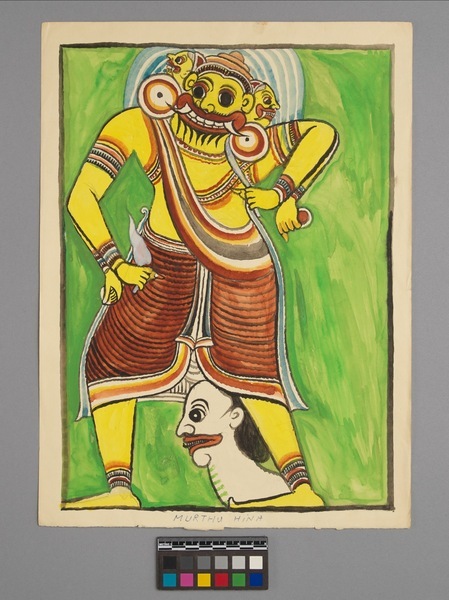Murthu Hina Item Number: 3392/33 from the MOA: University of British Columbia

Description
A watercolour painting which depicts a spiritual being with three heads and four arms. The figure has yellow skin, and is wearing a brown skirt that ends just below the knee. The bottom of the skirt has a thick border made up of white, yellow, and orange horizontal stripes. The main body of the skirt is covered in thinner horizontal stripes, and is made from two pieces which come together in the front. A long piece of fabric hangs down from the waist. A brown and yellow striped sash is draped diagonally across the being's chest. Additional adornments wrap around its chest and neck, and decorative armbands encircle its biceps, wrists, and ankles. The being is holding something in each of its hands, including two circular objects, a thin, curved knife, and a wavy, triangular object. All three of the being's heads have large, round eyes and fanged smiles. The centre head is the largest. It is looking forward, while the two smaller heads look to either side. The centre head is wearing a tiered headpiece that comes to a point at each side. It has a black beard that comes to seven, thin points, and two circular discs protrude from the side of its face. By the being's left foot is a disembodied head. It has white skin, black hair, a long neck. The head's tongue is thin and black, and protrudes outwards from red lips. The painting's background is green, and a rectangular black border surrounds the image. White and blue oblong rings radiate outward from the figure's heads and shoulders.
History Of Use
The imagery is possibly associated with ritual healing in Sri Lanka. The set of watercolours (3392/3-34) is said to depict spirits that inhabit planets, or deviyo (minor gods) or rakshas and yakkas (evil or mischievous beings). These beings are often depicted in masked dances and exorcisms.
Narrative
The collector, Dr. Michael Egan, wrote his doctoral thesis on healing rituals in Sri Lanka. His fieldwork was carried out in the south of Sri Lanka, in the village of Kadurupokuna (Hambantota District), between Sept. 1965 and Nov. 1966.
Item History
- Made in Sri Lanka between 1960 and 1966
- Collected between 1965 and 1966
- Owned by Michael John Egan before 1977
- Owned by Carol Egan before October 2, 2019
- Received from Carol Egan (Donor) on October 2, 2019
What
- Name
- Murthu Hina
- Identification Number
- 3392/33
- Type of Item
- painting
- Overall
- height 37.2 cm, width 27.4 cm
Who
- Culture
- Sinhalese
- Previous Owner
- Michael John Egan and Carol Egan
- Received from
- Carol Egan (Donor)
Where
- Holding Institution
- MOA: University of British Columbia
- Made in
- Sri Lanka
When
- Creation Date
- between 1960 and 1966
- Collection Date
- between 1965 and 1966
- Ownership Date
- before 1977 and before October 2, 2019
- Acquisition Date
- on October 2, 2019
Other
- Item Classes
- paintings; works on paper
- Condition
- good
- Accession Number
- 3392/0033